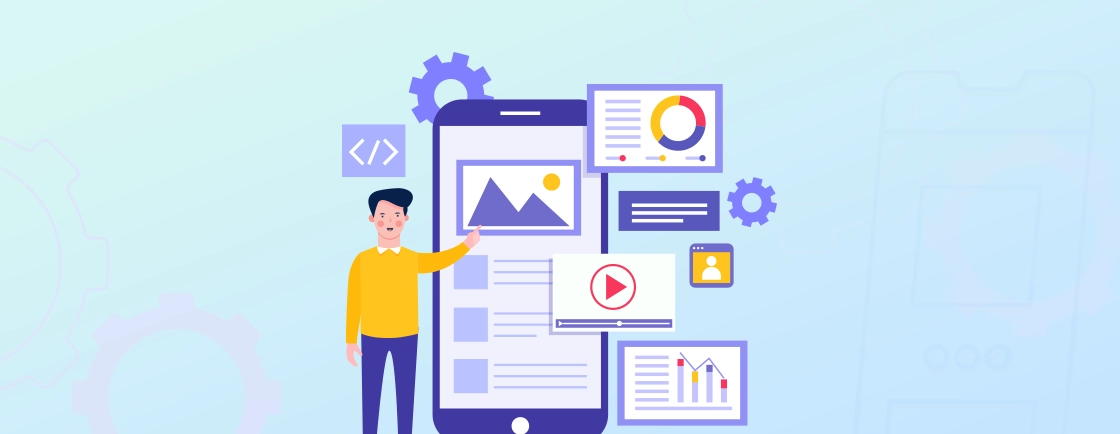Table of Contents
Of the many apps you must have on your phone, some run blazingly fast and others feel sluggish. And a few drain the battery way faster than expected. The difference often comes down to the language chosen by the developers.
Swift (for iOS) and Kotlin (for Android) power smooth native apps, while the likes of React Native and Flutter help build hybrid apps. They enable cross-platform development without sacrificing the performance.
But with so many options available, how do you choose the right one for your project? Well, this guide will explore the top mobile app development languages, their strengths and trade-offs, along with the real world applications. Let’s begin.
What is a Mobile App Development Language?
A mobile app development language is a programming language used to create applications for mobile devices like smartphones and tablets. These languages can be categorized based on the platform (iOS, Android, or cross-platform) and the development approach (native, hybrid, or cross-platform).
Each mobile app development language has its own rules (syntax and semantics). So the developers can express logic and define how an app behaves and interacts with users. Your choice of language will depend on the target platform, performance needs, developer expertise, and of course, the type of application.
Types of Mobile App Development Languages
We can categorize mobile app development languages based on the intended platform (iOS, Android, or cross-platform). And you need to consider the development approach, i.e. native, hybrid, or web-based, as well. Here’s a breakdown of the different types of mobile app development languages:
iOS App Development Languages
iOS app development languages are used to build mobile applications exclusively for the iOS ecosystem. That includes iPhones, iPads, and iPod Touch. These languages provide deep integration with Apple’s frameworks and hardware.
Key Languages
- Swift (Modern, fast, and Apple’s preferred language)
- Objective-C (Legacy language, still used for maintaining older apps)
Characteristics
- Optimized for Apple’s hardware (A-series/M-series chips)
- Full access to iOS-exclusive features (ARKit, CoreML, Face ID)
- Requires Xcode IDE and macOS for development
Android App Development Languages
Android app development languages are used to create apps for devices running Google’s Android OS. These languages leverage Android SDK and Jetpack libraries for optimal performance.
Key Languages
- Kotlin (Officially recommended by Google, concise and expressive)
- Java (Traditional, widely supported)
- C++ (Used for high-performance tasks via NDK)
Characteristics
- Runs on a variety of devices (phones, tablets, TVs, wearables)
- Supports open-source development with Android Studio
- Deep integration with Google services (Firebase, Maps, Play Store)
Cross-platform App Development Languages
Cross-platform languages allow developers to write a single codebase that works on both iOS and Android. It reduces the development time and cost while maintaining near-native performance for the applications.
Key Languages
- Dart (Flutter) (Google’s framework for high-performance UIs)
- JavaScript/TypeScript (React Native) (Facebook’s framework using native components)
- C# (Xamarin) (Microsoft’s solution for .NET developers)
Characteristics
- Single codebase for multiple platforms.
- Access to native APIs via bridges or plugins.
- Faster development cycles but may have slight performance trade-offs.
Hybrid App Development Languages
Hybrid app development combines web technologies (HTML, CSS, JavaScript) with a native mobile wrapper. So you can create apps that run inside a WebView but are distributed via mobile app stores.
Key Frameworks
- Ionic (Angular/React/Vue-based, Cordova plugins for native features)
- Apache Cordova/PhoneGap (Wraps web apps in a native shell)
Characteristics
- Cheaper and faster to develop than native apps.
- Runs on any platform but may lack performance in complex apps.
- Best for simple apps, PWAs, or content-driven applications.
Out of these language types, your choice should be based on performance and codebase requirements, along with other key aspects of the project.
Best Programming Languages for Mobile App Development
There are several outstanding languages available for the best mobile app development. Here are a few popular ones.
Swift
Swift is Apple’s modern, fast, and intuitive language for building iOS apps. Designed for performance, it eliminates legacy issues of Objective-C with cleaner syntax, safety features, and powerful memory management. Swift is the top choice for building high-performance iPhone, iPad, and Mac apps, supported by Apple’s robust frameworks like SwiftUI and UIKit.
Key Features of Swift
- Modern & Safe: Strong typing, optionals, and memory management prevent crashes.
- Fast Performance: Compiled to native code, optimized for Apple hardware.
- Easy Syntax: Clean, readable code (similar to Python/JavaScript).
- Interoperable with Objective-C: Can use both in the same project.
- Apple Ecosystem Support: Full access to iOS, macOS, watchOS, and tvOS APIs.
Pros & Cons of Swift
| Pros | Cons |
|---|---|
| – Fast and efficient performance – Modern syntax, easy to read/write – Safe (type-safe, memory-safe) – Interoperable with Objective-C – Strong community and open-source | – Limited support for older iOS versions – Rapid changes, sometimes lack stability – Smaller talent pool than Java/ObjC – Young, evolving language – Less mature compared to ObjC |
Objective-C
Objective-C, Apple’s original iOS language, is still used in legacy apps. While overshadowed by Swift, it remains relevant for maintaining older codebases. This language combines C’s performance with Smalltalk-style messaging. It offers deep iOS framework access but with a steeper learning curve due to its verbose syntax.
Key Features of Objective-C
- Dynamic Runtime: Allows method swizzling and dynamic typing.
- C Compatibility: Can mix C and C++ code easily.
- Mature & Stable: Used in Apple apps for decades.
- Message-Passing Syntax: Unique [object method] style.
- Backward Compatibility: Still used in older iOS/macOS projects.
Pros & Cons of Objective-C
| Pros | Cons |
|---|---|
| – Mature, well-documented, stable – Dynamic runtime behavior – Compatible with legacy codebases – Large library & framework support – Reliable for enterprise apps | – Verbose, complex syntax – Slower development than Swift – Shrinking popularity/community – Lacks type safety, fewer modern features – Higher learning curve, less secure |
Kotlin
Kotlin is Google’s preferred language for building Android apps, praised for its conciseness and safety features. Fully interoperable with Java, it reduces boilerplate code while improving readability. Jetpack Compose, Kotlin’s declarative UI framework, accelerates modern Android app development. That makes it a top choice for developers.
Key Features of Kotlin
- Concise Syntax: Less boilerplate than Java (e.g., data classes).
- Null Safety: Compiler prevents null pointer exceptions.
- Interoperable with Java: Can use Java libraries seamlessly.
- Coroutines: Built-in support for async programming.
- Multiplatform: Shared code between Android, iOS, and web (KMM).
Pros & Cons of Kotlin
| Pros | Cons |
|---|---|
| – Concise, intuitive syntax – Java interoperability – Safer, less buggy code – Good IDE/tool support – UI frameworks like Jetpack Compose | – Fluctuating compile speeds – Relies on underlying JVM/Android implementations – Need basic Java knowledge for legacy projects – Smaller community vs. Java – Can be new for some teams |
Java
Java, the traditional language for Android, remains widely used due to its stability and vast ecosystem. While Kotlin is now preferred, Java’s portability, strong community, and extensive libraries ensure its relevance, especially in enterprise apps and legacy Android projects.
Key Features of Java
- Platform Independence: “Write once, run anywhere” (JVM-based).
- Strong Ecosystem: Huge libraries (e.g., Spring, Android SDK).
- Object-Oriented: Strict OOP principles (inheritance, encapsulation).
- Backward Compatibility: Long-term support for older versions.
- Performance: JIT compilation for optimized execution.
Pros & Cons of Java
| Pros | Cons |
|---|---|
| – Platform independent (“write once, run anywhere”) – Large developer community – Object-oriented design – High security – Extensive libraries and frameworks | – Performance overhead (JVM) – Can be verbose/complex, longer dev time – Memory consumption – Slower GUI/UX performance – Steep learning curve |
React Native
React Native, powered by JavaScript, enables cross-platform mobile app development with near-native performance. Developed by Facebook, it allows code reuse between iOS and Android while leveraging React’s component-based architecture. Hot reloading speeds up development, making it ideal for startups and rapid prototyping.
Key Features of React Native
- JavaScript/TypeScript: Uses familiar web dev skills.
- Hot Reloading: Instant UI updates during development.
- Native Components: Renders to native views (not WebView).
- Large Community: Supported by Meta (Facebook), many plugins.
- Single Codebase: Build for iOS and Android simultaneously.
Pros & Cons of React Native
| Pros | Cons |
|---|---|
| – Cross-platform (single codebase) – Fast dev, hot reload – Large open-source community – Code reuse, modular architecture – Good UI/UX toolkit | – Larger app size than native – Limited access to some native features – Performance hit vs. true native – Platform-specific UI inconsistencies – Dependency on third-party libs |
JavaScript
JavaScript is the backbone of hybrid and cross-platform mobile development. With frameworks like React Native, Ionic, and NativeScript, it bridges web and mobile app development. So developers can build apps using familiar web technologies while accessing native device features.
Key Features of JavaScript
- Versatile: Runs in browsers, servers (Node.js), and mobile (React Native).
- Dynamic Typing: Flexible but can lead to runtime errors.
- Event-Driven: Asynchronous with Promises/async-await.
- Huge Ecosystem: npm has the largest package registry.
- PWAs & Hybrid Apps: Powers Ionic, Cordova, and Capacitor.
Pros & Cons of JavaScript
| Pros | Cons |
|---|---|
| – Widely known language – Fast prototyping/development – Strong framework ecosystem – Flexible, dynamic – Good for hybrid apps | – Performance limitations vs. native – Security concerns (web vulnerabilities) – Browser/platform differences – Limited native API access – Frequent updates, fragmentation |
HTML5
HTML5 is key for Progressive Web Apps (PWAs) and hybrid mobile development. While not a standalone app language, it works with CSS and JavaScript to create web-based mobile experiences. PWAs offer offline functionality and app-like interfaces without requiring app store distribution.
Key Features of HTML5
- Semantic Tags: <header>, <section>, <article> for better SEO.
- Offline Support: Service Workers enable PWAs.
- Multimedia: Native <video> and <audio> tags.
- Canvas/WebGL: For 2D/3D graphics and games.
- Cross-Platform: Works on all devices with a browser.
Pros & Cons of HTML5
| Pros | Cons |
|---|---|
| – Cross-platform, single codebase – Cost-effective and fast dev – Easy updates, maintainability – Web searchable, SEO benefits – Flexibility for UX | – Slower performance than native – Dependent on browser and connectivity – Compatibility issues, fragmentation – Limited offline access – Vulnerable to code injection |
HTML & CSS
HTML and CSS are essential for hybrid mobile apps (e.g., Ionic, Cordova) and PWAs. They structure and style app interfaces, allowing web developers to transition into mobile development. While not native, they enable rapid prototyping and cross-platform compatibility.
Key Features of HTML & CSS
- Structure + Styling: HTML defines content, CSS handles design.
- Responsive Design: Flexbox, Grid, and media queries.
- Animations: CSS transitions and keyframes.
- Preprocessors: SASS/SCSS for reusable styles.
- Theming: Variables for consistent UI theming.
Pros & Cons of HTML & CSS
| Pros | Cons |
|---|---|
| – Easy to learn and write – Universal compatibility – Responsive design possible – Huge support/resources – Open-source, fast prototyping | – Limited capability for complex apps – Not suitable for high-performance apps – Browser-dependent, device compatibility – Troubleshooting can be time-consuming – Security limitations |
C#
C# is the primary language for Xamarin and .NET MAUI, enabling cross-platform mobile development with native performance. Microsoft’s ecosystem integrates seamlessly with Visual Studio, making it a strong choice for enterprises and developers familiar with .NET.
Key Features of C#
- Strong Typing: Reduces runtime errors.
- LINQ: Powerful data querying syntax.
- Cross-Platform: Xamarin/.NET MAUI for mobile, Unity for games.
- Async/Await: Clean asynchronous programming.
- Microsoft Ecosystem: Integrates with Azure, Visual Studio.
Pros & Cons of C#
| Pros | Cons |
|---|---|
| – Fast performance – Rich library support – Object-oriented, easy readability – Good for cross-platform (Xamarin/.NET) – Good for enterprise, games (Unity) | – Heavily reliant on .NET – Limited mobile support vs. native – Can add layers of complexity – Larger app sizes – Windows-centric, not ideal for all platforms |
C/C++
C and C++ are used for high-performance mobile apps, particularly in game development (Unreal Engine) and Android NDK for CPU-intensive tasks. While not typical for standard apps, they provide low-level hardware control for demanding applications.
Key Features of C/C++
- Low-Level Control: Direct memory manipulation.
- High Performance: Used in game engines (Unreal) and Android NDK.
- Portable: Runs on almost any hardware.
- Multi-Paradigm: Supports OOP and procedural programming.
- Large Libraries: Boost, STL, and OpenGL for graphics.
Pros & Cons of C/C++
| Pros | Cons |
|---|---|
| – Fast and highly efficient – Low-level hardware access – Portable, cross-platform – Total memory control- Extensive libraries | – Difficult to learn, maintain – Integration challenges – Security issues (manual memory management)- Lacks modern language features – Higher dev costs for complex apps |
Dart
Dart, the language behind Flutter, is optimized for fast, natively compiled apps. Its reactive framework enables beautiful, high-performance UIs across iOS and Android with a single codebase. Flutter’s growing popularity makes Dart a rising star in cross-platform development.
Key Features of Dart
- Ahead-of-Time (AOT) Compilation: Native performance.
- Hot Reload: Fast UI iteration during development.
- Widget-Based UI: Customizable, composable widgets.
- Null Safety: Reduces crashes (like Kotlin).
- Single Codebase: Compiles to iOS, Android, web, and desktop.
Pros & Cons of Dart
| Pros | Cons |
|---|---|
| – Single codebase for multiple platforms – Fast performance, hot reload – Rich UI capabilities – Cost and time efficient – Native-like experience | – Large app sizes – Less popular, smaller talent pool – Limited third-party library support – Some issues on iOS – Learning curve for Dart |
There are several other languages and frameworks available to create the best mobile apps. You need to choose between them based on your project requirements and technical proficiency.
How to Choose the Best Mobile App Development Language?
Choosing the best mobile app development language depends on several factors. That includes your project requirements, target audience, budget, and team expertise. Here’s a step-by-step guide to help you decide:
App’s Purpose & Requirements
The nature of your app dictates the best language. A high-performance game will need C++ (Unreal Engine) or C# (Unity), while a simple business app might thrive with Flutter or React Native.
If your app requires deep hardware integration (e.g., AR, advanced camera features), native languages (Swift/Kotlin) are essential.
Target Platform
If you’re only targeting iOS, Swift is the best choice. For Android-only, Kotlin is ideal. However, if you need both platforms, cross-platform solutions (Flutter, React Native, Xamarin) save time and cost.
Hybrid apps (Ionic, Cordova) work for simple apps but sacrifice performance.
Development Speed & Cost
Startups and MVPs often prefer cross-platform (Flutter, React Native) because they allow one codebase for two platforms, reducing development time by 30-50%.
Native apps (Swift/Kotlin) take longer but offer better performance. PWAs (HTML5/JS) are the cheapest but lack native features.
Team’s Expertise
If your team knows JavaScript, React Native is a natural fit. C# developers can leverage Xamarin, while web devs might prefer Ionic/Capacitor. Learning Swift/Kotlin requires investment but pays off for long-term native projects.
App’s Performance Needs
Native apps (Swift/Kotlin) deliver the best speed, smooth animations, and low battery usage. Cross-platform (Flutter/RN) is near-native but may lag in graphics-heavy apps. Hybrid apps (Ionic) suffer in performance due to WebView rendering.
Long-term Maintenance & Scalability
Native apps are easier to maintain because Apple/Google prioritize their own languages. Cross-platform frameworks depend on third-party updates (e.g., Flutter’s compatibility with new iOS/Android versions). Hybrid apps can become outdated quickly if not maintained.
Ecosystem & Community
A strong community means more libraries, tutorials, and Stack Overflow solutions. JavaScript (React Native) has the largest ecosystem, while Dart (Flutter) is growing fast. Objective-C and Xamarin have declining communities.
By evaluating these factors, you can confidently select the best mobile app development language for your project. And if you are still not sure about which of these languages is suitable for you, get our expert mobile app development services. We’ll evaluate your project requirements and proceed with the suitable option accordingly.
Role of MBaaS (Mobile Backend as a Service) in App Development
MBaaS is a cloud-based platform that provides ready-to-use backend infrastructure for mobile apps. It eliminates the need to build and manage servers, databases, APIs, and other backend components from scratch.
Instead, developers can integrate pre-built features like user authentication, cloud storage, push notifications, and database management. It saves time and reduces development costs.
How Does MBaaS Work?
- Pre-Built Backend Services: MBaaS providers (like Firebase, AWS Amplify, or Back4App) offer APIs and SDKs for common functionalities, such as:
- User Authentication (Social logins, email/password)
- Database & Storage (NoSQL databases, file storage)
- Push Notifications (Real-time alerts)
- Serverless Functions (Cloud-based code execution)
- Easy Integration: Developers connect their mobile app (iOS/Android) to the MBaaS platform via SDKs or REST APIs, avoiding manual server setup.
- Scalability & Security: The cloud provider handles server maintenance, scaling, and security (e.g., data encryption, DDoS protection).
- Real-Time Updates: Many MBaaS solutions support real-time data sync (e.g., Firebase Realtime Database) for live app updates.
MBaaS provides a cloud-based infrastructure for backend development. It eliminates the need to build and manage servers, databases, APIs, and authentication systems from scratch. So developers can focus on building great user experiences rather than server management.
While it’s not a one-size-fits-all solution, it’s a powerful tool for rapid prototyping and small-to-medium apps.
Let’s Summarize
Choosing the right mobile app development language depends on your project’s needs. Like, performance, cross-platform support, development speed, or long-term scalability.
Native languages like Swift and Kotlin deliver the best experience for platform-specific apps. And, Flutter and React Native offer a balanced approach for building across iOS and Android with a single codebase.
Ultimately, the best language aligns with your app’s goals, your team’s expertise, and future maintenance plans. So, want to build the best mobile app with the most suitable language? Then hire mobile app developers with us today!
FAQs on Mobile App Development Languages
Which language is best for iOS app development?
Swift is Apple’s preferred language—modern, fast, and easy to learn. Objective-C is still used for legacy apps but is fading.
What’s the best language for Android apps?
Kotlin is Google’s recommended language, offering concise syntax and safety. Java is still used but considered outdated for new projects.
Can I use one language for both iOS and Android?
Yes! Flutter (Dart) and React Native (JavaScript) allow cross-platform development with a single codebase, saving time and cost.
What’s the fastest language for mobile apps?
Native languages (Swift, Kotlin, C++) deliver the best speed. Flutter is close, while hybrid apps (HTML/JS) are the slowest.
Which language is best for gaming apps?
C# (Unity) and C++ (Unreal Engine) dominate mobile game development due to high performance and graphics control.
Can I build apps without coding?
Low-code tools (like FlutterFlow or Adalo) exist, but custom features still require programming in Swift, Kotlin, or JavaScript.
Elevate Your App Development Journey
Explore comprehensive guides, industry trends, and expert advice to build innovative mobile applications.





